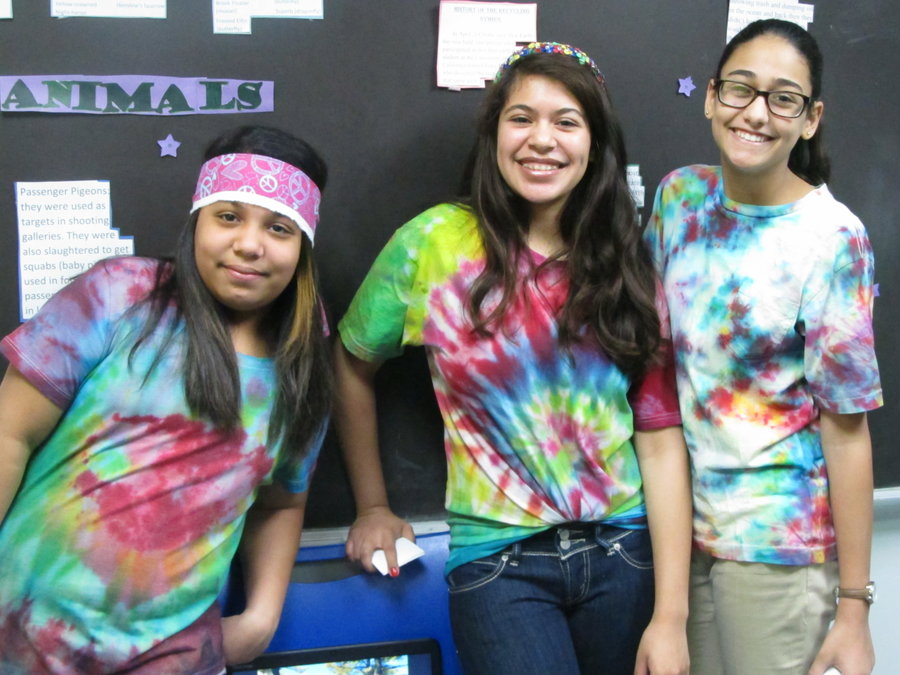Explore 2000 is a kind of middle school at the Jersey City campus of the Hudson County Schools of Technology, a countywide public school system attended by kids throughout the county. The program has a unique take on education that emphasizes project studies rather than the usual classroom activity.
The program is consistent with the New Jersey Core Curriculum Content Standards, but uses thematic, hands-on, student-centered interdisciplinary activities and accelerated learning based on real-life experience. Students work on their projects for months, then present their findings at symposiums.
Recently, middle school students from around Hudson County explored the impact of environmental pollution and possible solutions as part of their year-end project. For two days in mid-December, students showed off what they learned for parents and other members of the public.
“I didn’t know there was so many ways we can help every day.” – Aidan Gonzalez
____________
Teams of students tackled various aspects of pollution, endangered species, and at-risk environments, and gave presentations that together gave an overall report card on risks to the earth, and talked about how what they learned might influence the career paths they’ve set for themselves.
Carola Peraque, Amaya Montaez, and Ariana Young gave an overview of species gone extinct in New Jersey and what might be done to prevent future losses.
“I didn’t know there were so many,” said Jersey City resident Peraque. Her ambition is to establish an environmental foundation in the future. “This is something that is still going on.”
Montaez was also shocked by the number of extinct animals in New Jersey, and said she was unaware of how bad the problem was until she prepared for the symposium.
Seventh grader Young, also of Jersey City, has ambitions to become an artist in the future. She said the lesson was a sobering one, especially the threat to the ecosystem.
“This involved different field trips,” said science teacher Lauren Norcia, who facilitated this part of the program. “The students did research and came up with the idea for the showcase.”
How to prevent destruction
One team of students included Keverly Encarnacion and George Vogiattis of Jersey City, Dave Serena of North Bergen, and Matthew Torres Jr. and Aidan Gonzalez of Hoboken. They worked on ideas to prevent destruction of the ecosystem, such as avoiding products that pollute the water supply or destroy plants and trees, the use of recycled products, more energy efficient light bulbs, and the use of showerheads that waste less water.
Encarnacion, who envisions a future career as a graphics or fashion designer, said the spread of fertilizer into the oceans came as a surprise. “I didn’t know that happened.”
Serena said he learned a lot about the water supply, mainly the risks and the possible solutions. He admitted he wasn’t sure how this would fit into his career path, although he said he was sure much of what he learned will stay with him whatever he does.
Vogiattis is working towards a future in animal science, perhaps becoming a veterinarian. The project taught him about the threats animals face.
“We pollute animal habitats,” he said. “And this is all part of the food chain.”
Torres said the project fit very well with his ambition to become a marine biologist. He learned from this study how polluted water makes it difficult for marine animals to breathe.
Gonzalez said he hopes he can help develop vehicles that do not pollute. His ambition is to become a mechanical engineer.
“This inspired me,” he said. “I didn’t know there was so many ways we can help every day.”
The resource center’s map
Robbie Bacos, Lavanique Harps, Alenna Ali, and Angelina Ponze operated the resource center for the event. The facility came complete with a map of wild life centers from around New Jersey, places in nearly every county people can interact with nature, some larger than others, but all of them places where people can learn.
For Harps of Jersey City, the lessons struck a chord. He hopes to become a plastic surgeon some day, but was another student who was not sure yet how what he learned would fit in with his plans.
Ali intends to become a teacher, and said the lesson will fit in her future. “I didn’t know all the information available,” the Jersey City resident said.
Ponze, of West New York, hopes to become a fashion designer. She said she was surprised by how many environmentally troubled places there were around the state.
Dealing with issues such as solid waste and the impact of chemical disposal as well as discarded technology, Christopher Casavecchia, George Bebawy Amar Arslanovic, and Cole Goodman teamed up to reveal how large a problem this was and what can be done about it.
Casavecchia of Jersey City said he learned how people affect the world they live in, knowledge that might be useful if he becomes a police detective some day.
Bebawy of Jersey City hopes to become a doctor, and said he came to understand how pollution can affect people’s health.
Future engineer Arslanovic of Jersey City said he’s taken to heart what he learned about how human behavior can hurt or help the environment.
Goodman said this lesson doesn’t really fit into his plans to become a video game designer.
“Still, I didn’t know a lot about what chemicals do to the environment or how big a carbon foot print we leave on the planet,” the North Bergen resident said.
Al Sullivan may be reached at asullivan@hudsonreporter.com.
